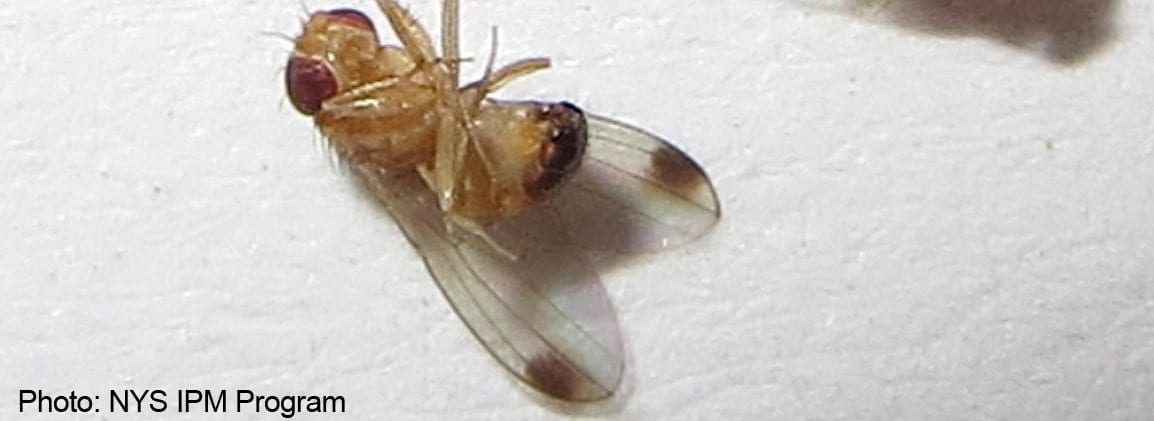Two farms in Orleans County where monitoring is underway for SWD detected their first catch in traps on June 28, 2021. 1 male and 1 female SWD in a blueberry planting and 2 females in a raspberry planting.

These traps are being monitored by Janet van Zoeren, Lake Ontario Fruit Program, CCE. Janet relayed that the crops at both locations are just entering harvest.
The blueberries range from beginning to color to nearly ripe. There are various varieties and harvest began around June 30.
The earliest raspberries are ripe, most are between hard and green to just beginning to soften.
Cooler weather, along with moist humid conditions, will favor SWD. It will be very important to remember and implement the foundations of SWD management.
SWD Management entails 5 key tactics:
- Excellent sanitation will reduce SWD populations.
Fruit should be harvested frequently and completely to prevent the buildup of ripe and over-ripe fruit. Unmarketable fruit should be removed from the field and either frozen, “baked” in clear plastic bags placed in the sun, or disposed of in bags off-site. This will kill larvae, remove them from your crop, and prevent them from emerging as adults.
- Canopy and water management will make the environment less favorable.
Prune to maintain an open canopy, increase sunlight and reduce humidity. This will make plantings less attractive to SWD and will improve spray coverage. Repair leaking drip lines and avoid overhead irrigation when possible. Allow the ground and mulch surface to dry before irrigating.
- Insecticide sprays will kill SWD adults and thereby reduce egg laying.
Insecticide treatments should begin when either regional monitoring alerts about the first SWD trap catch or when highly susceptible fruit crops, such as raspberries and blackberries, are ripening. Treatments should be applied at least every seven days and repeated in the event of rain. Choose the most effective insecticides with pre harvest intervals that work for your picking schedule. Rotate insecticides according to their modes of action. Quick reference guides are on the SWD Management web page, fruit.cornell.edu/spottedwing/management/. Check the Cornell Guidelines for your crop (cropandpestguides.cce.cornell.edu/) for the latest list of approved pesticides. Always read and follow the pesticide label instructions.
- Regular fruit sampling.
At least 100 fruit per block per harvest should be observed for infestation. Talk to your local CCE agent about a monitoring program. Fruit can be inspected for evidence of larval feeding. Small holes in berries where the eggs were laid may leak juice when the berry is gently squeezed; this is especially diagnostic on blueberry. Infested red raspberry fruit may leave a red juice stain on the berry receptacle when the fruit is picked. Fruit with small indents or bruises where the berry surface appears to have flattened or deflated may be damaged.
A salt flotation method, immersing fruit in a solution of 1 Tbsp. (14.8 cc) table salt per 1 cup (236.6 ml) water, may cause larvae to float to surface. At least 100 fruit per block per harvest should be observed for infestation. Suggested methods were adapted for NY growers in Guidelines for Checking Fruit for SWD Larvae in the Field.
- Cool berries immediately.
Chilling berries immediately after harvest to 32° – 34° F will slow or stop the development of larvae and eggs in the fruit. U-Pick customers should be encouraged to refrigerate fruit immediately to maintain fruit quality at home.

